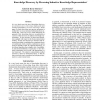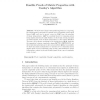210 search results - page 22 / 42 » A Formal Theory of Key Conjuring |
FORTE
2008
13 years 8 months ago
2008
In software engineering, graphical formalisms, like state-transition tables and automata, are very often indispensable parts of the specifications. Such a formalism usually leads t...
KR
2004
Springer
14 years 23 days ago
2004
Springer
In a very basic sense, the aim of knowledge discovery is to reveal structures of knowledge which can be seen as being represented by structural relationships. In this paper, we ma...
CSL
2005
Springer
14 years 28 days ago
2005
Springer
We show that Csanky’s fast parallel algorithm for computing the characteristic polynomial of a matrix can be formalized in the logical theory LAP, and can be proved correct in LA...
IJON
2006
13 years 7 months ago
2006
Sensory systems often use groups of redundant neurons to represent stimulus information both during transduction and population coding of features. This redundancy makes the syste...
IASTEDSEA
2004
13 years 8 months ago
2004
Program transformation through the repeated application of simple rewrite rules is conducive to formal verification. In practice, program transformation oftentimes requires data t...


